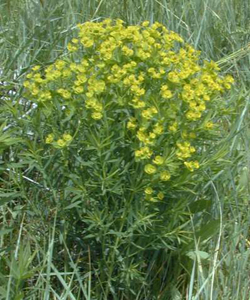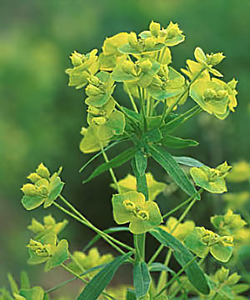Invasive Plants and Agricultural Pest Management
Welcome to Alaska's Invasive Plant Program. Our program coordinates prevention, outreach and management strategies for invasive plant issues through collaboration with land managers, agencies, organizations and policy makers across Alaska. These efforts are guided by the implementation of our Strategic Plan and relevant noxious weed regulations and policies. Our goal is to help keep Alaska's pristine landscapes and natural resources free from impacts of noxious and invasive plants.
PMC Programs
- PMC Home Page
- Horticulture
- Industrial Hemp
- Invasive Plants
- Plant Pathology

5310 S Bodenburg Spur
Palmer, AK 99645
Phone: 907-745-4469
Fax: 907-746-1568
Mon. - Fri.
8 a.m. - 4 p.m.
Click Map For Directions
View Larger Map
Leafy spurge (Euphorbia esula)
AK Natural Heritage Program Invasiveness Ranking: 84
Leafy spurge is listed as a noxious weed in Alaska, 22 other states and Canada.
- Biology
- Impact
- Distribution
- Taking Action
- Resources
- • Long-lived perennial herb
- • Deeply rooted
- • Grows up to 32 inches tall
- • Vigorous rhizomes
- • Stems are hairless, pale green and somewhat woody
- • Leaves are alternate, narrow, and bluish-green and grow 1-4 inches long
- • Flowers are small and yellowish-green and grow in clusters
- • One female flower is generally surrounded by 11 to 21 male flowers; all of which are arranged inside a cup-like involucre of five, fused bracts
- • Flowers are backdropped by paired, heart-shaped, yellow-green bracts
- • One plant can produce up to 130,000 seeds
- • The three-sided seed capsule explodes when ripe and projects seeds up to 15 feet away


Leafy spurge can reduce species diversity and exclude native forage populations. Due to the unpalatable and toxic properties, most grazing animals avoid it. Disturbances in soils promote the establishment of leafy spurge, allowing it to take over roadsides and developing areas. Leafy spurge can be carried in commercial seed, forage and hay; potentially impacting agricultural areas of the state.
Leafy spurge has not been found in Alaska, but grows throughout most of Canada. It also has been documented in 35 states.
Habitat: pastures and rangelands, waste areas and abandoned croplands, roadsides, developing areas, open meadows and woodlands
The most effective method of controlling leafy spurge is to prevent its establishment through land management. If you find a new infestation, call 1-877-INVASIV.
Due to the extensive root system, hand-pulling this plant is not an effective management method. Mowing will reduce seed production if repeated every 2 to 4 weeks during the growing season, but will provide little long-term control. Establishing selected native grasses has been proven effective. Herbicide applications may also be effective.
